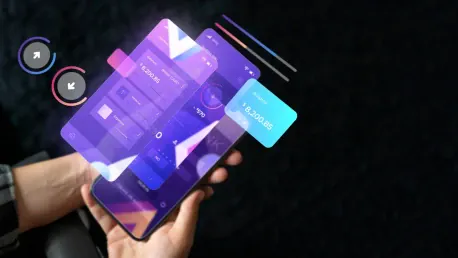Smartphone-based augmented reality (AR) applications have revolutionized how we interact with our surroundings, overlaying digital elements onto the real world through a phone’s camera. Despite their popularity in various fields such as gaming, navigation, and interior design, these applications face significant challenges when used indoors. Researchers from Osaka University have delved into these issues, presenting their findings at the 30th Annual International Conference on Mobile Computing and Networking.
The Core Challenges of Indoor AR
Localization and Tracking Difficulties
One of the primary hurdles for indoor AR is the accurate localization and tracking of the smartphone. These processes rely on visual sensors like cameras and LiDAR, as well as the phone’s inertial measurement unit (IMU). However, indoor environments often lack clear GPS signals, complicating these tasks. The researchers from Osaka University conducted extensive experiments to understand how these systems perform under various constraints.
For accurate localization, the phone must identify its position while tracking determines its movement. Visual sensors capture surroundings and IMU measures motion, together driving AR’s core functions. Yet indoor GPS inaccuracies disrupt sensor performance. Researchers devised controlled setups to identify specific failures. Test environments ranged from plain walls to visually rich spaces, under varied light conditions, isolating individual sensors to measure their impact. The study revealed how constraints affected visual and inertial sensors in recreations of lectures, cluttered rooms, and dim halls.
Experimental Setup and Methodology
To investigate, the researchers created controlled environments with different levels of complexity. They varied the presence and use of sensors by blocking specific components of the smartphone, ensuring scenarios where only certain sensors were active. These environments ranged from simple white walls to cluttered spaces filled with objects, and lighting conditions varied from dim to bright. The movement types were standardized using a specially designed XY-stage, ensuring repeatable conditions.
Over 113 hours of experiments and 316 tested patterns provided insights into sensor performance. Tasks mimicking real-life scenarios, like arranging virtual objects in rooms, highlighted issues under strict controls. Environments included minimalistic spaces for pure sensor input and complex scenarios to stress sensors’ accuracy. This thorough examination let researchers isolate weaknesses of visual tracking, IMU drifts, and light dependency. Patterns, motion under standardized testing, and varying scenes shed light on sensor performance, paving the way for potential solutions.
Key Findings from the Experiments
Sensor Performance Under Different Conditions
The experiments, spanning 113 hours and involving 316 pattern variations, revealed several common issues. Virtual elements often drifted, causing disorientation and motion sickness. Visual landmarks were hard to detect from afar, at acute angles, or in low light conditions. LiDAR was inconsistent in cluttered environments, and the IMU exhibited cumulative errors over time, especially at high or low speeds.
Researchers’ observations underline critical failings in smartphone-based AR performance indoors. Poor performance emerged when visual landmarks were sparse, at steep angles, or faintly lit conditions intensified tracking errors. LiDAR’s reliability fluctuated in object-filled rooms. Prolonged use of IMUs resulted in accumulated inaccuracies, especially notable during rapid or sluggish movements. Such disparities often loosen AR’s grip on real-object alignments, leading to reduced realism and immersion.
Impact of Environmental Factors
The researchers found that environmental factors significantly impacted sensor performance. In simple environments with few visual features, tracking was more reliable. However, in cluttered spaces, the sensors struggled to maintain accuracy. Lighting conditions also played a crucial role, with dim lighting posing more challenges than bright lighting.
The influence of surroundings on sensor accuracy was evident. Environments lacking distinct features enabled better sensor syncing, while clutter increased error rates significantly. Lighting played a decisive role, as dim conditions often impaired sensor functionality and recognition ability. Experimentation showcased how specific factors like minimal visual elements and adequate lighting are conducive to more stable AR, pinpointing exact failure modes spurred by uncontrolled clutter and poor illumination.
Proposed Solutions for Enhanced Indoor AR
Integration of Radio-Frequency-Based Localization
To address these challenges, the researchers suggest integrating radio-frequency-based localization, specifically ultra-wideband (UWB) sensing. UWB operates similarly to WiFi or Bluetooth and is used in smart tags like Apple AirTag and Galaxy SmartTag+. Unlike vision-based methods, UWB is not constrained by line-of-sight or lighting conditions, offering more reliability indoors.
UWB’s potential to bypass limitations inherent in visual and inertial-based navigation marks it as a promising alternative. Its function is comparable to common wireless technologies but excels in uninterrupted, line-of-sight-independent tracking. Such an approach promises more stable indoor AR. Radio-frequency methods enhance reliability by sidestepping visual occlusion and lighting variances, thus offering a robust solution to the prevalent issues uncovered by Osaka University’s research.
Hybrid Approach for Robust Performance
The study underscores the potential of combining radio-frequency-based solutions with current vision-based techniques. This hybrid approach could include UWB, ultrasound, WiFi, Bluetooth Low Energy (BLE), or Radio-frequency identification (RFID). By merging these technologies, the limitations of individual methods can be mitigated, leading to more robust and effective AR experiences indoors.
The integration of various sensing technologies stands to transform indoor AR significantly. Blending visual and radio-frequency-based solutions addresses individual weaknesses while maximizing strengths. Such synergy promises enhanced performance, reducing risks of sensor failure under varied conditions. The hybrid system could seamlessly adapt, maintaining accuracy amidst diverse indoor environments. This method fosters technological synergy, enriching user experience by ensuring resilient and realistic AR applications irrespective of indoor impediments.
Future Directions for Indoor AR Development
Enhancing User Experience
The integration of diverse sensing modalities promises to enhance the viability and usability of AR applications across multiple indoor scenarios. By addressing the core challenges identified in the study, future AR technologies can offer a more seamless and immersive user experience.
Enhanced user experience remains central to advancing AR applications. Addressing environmental and sensor-specific issues can provide smoother, more immersive AR interactions. As researchers refine solutions, future applications are expected to offer core reliability, lessening disturbances like disorientation and motion sickness. These improvements will ultimately enrich user satisfaction and engagement in diverse fields, ranging from gaming to professional tasks, nurturing wider AR adoption.
Continued Research and Innovation
Researchers at Osaka University have conducted in-depth studies to understand these indoor AR challenges better. They shared their insights and discoveries at the 30th Annual International Conference on Mobile Computing and Networking. Their work highlights the obstacles AR technologies face indoors, such as varying lighting conditions, limited space for accurate spatial mapping, and the difficulty of maintaining a stable connection with location services. These findings are essential for advancing AR technology and expanding its reliable use in indoor settings, where its potential could be revolutionary.









